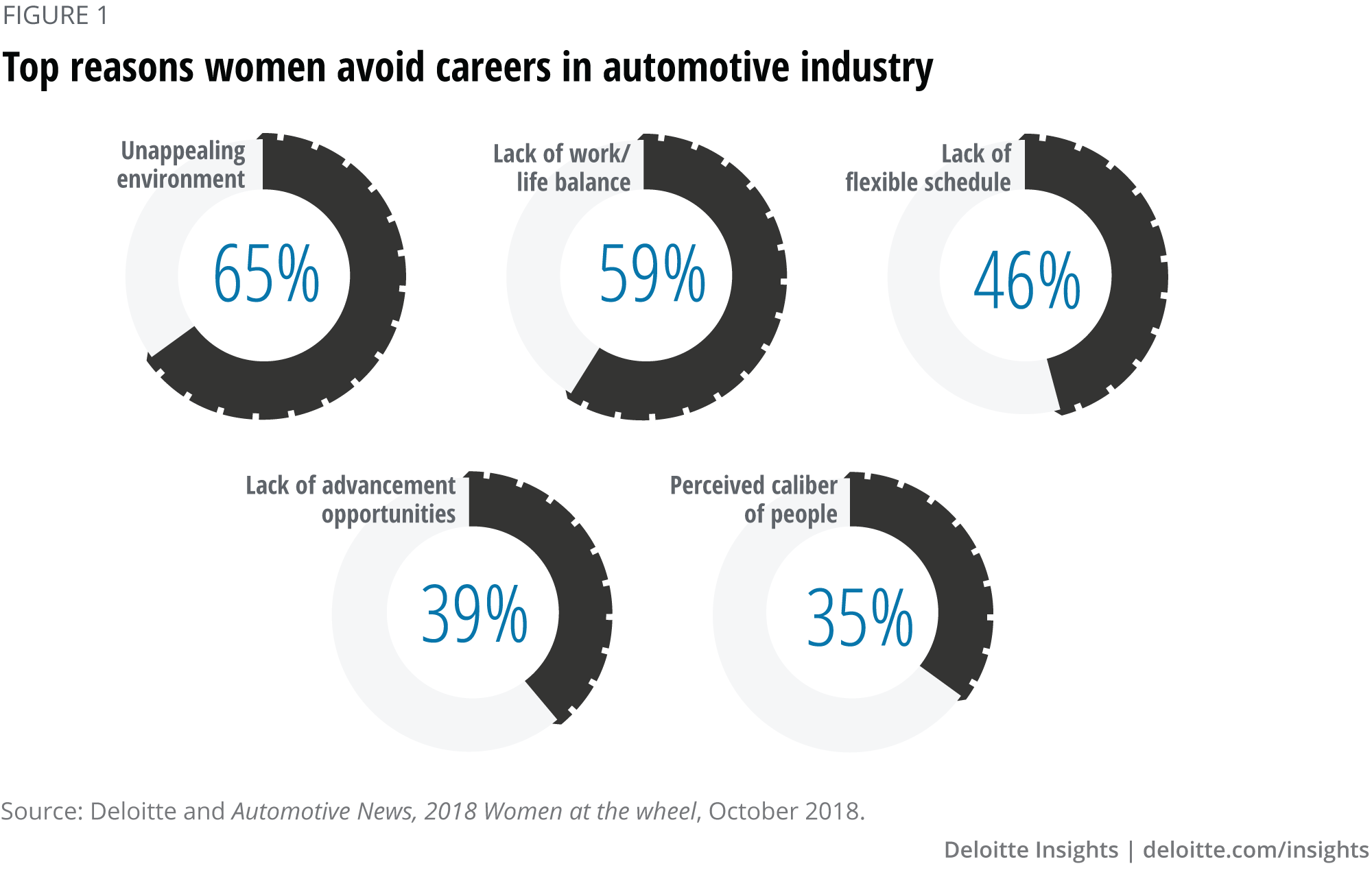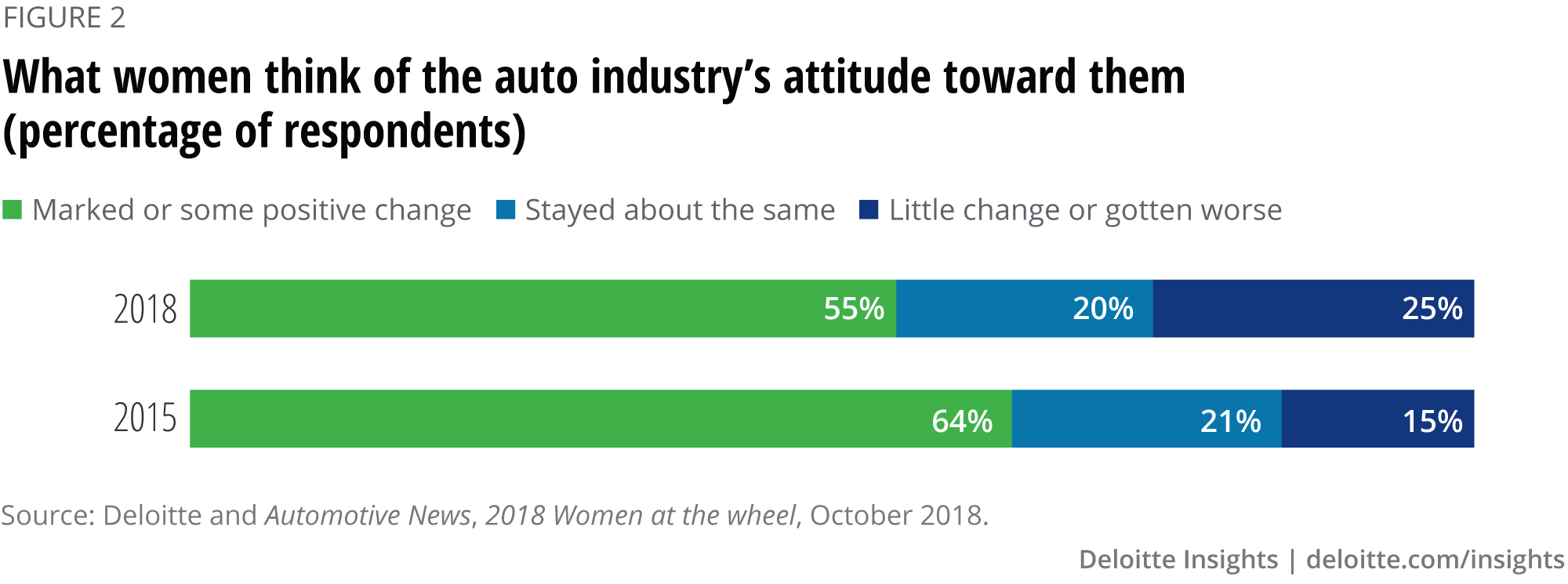
Shifting diversity into high gear Helping to close the auto industry’s talent gap
8 minute read
30 May 2019
Even as the automotive industry gears up to race ahead with electric mobility and self-driving cars, it’s being held back by a deepening talent crisis. Women—an often largely underutilized resource in the automotive sector—can help pull auto companies out of this rut.
Today, women account for only 27 percent of the US auto manufacturing workforce as compared to about 47 percent of the overall labor force.1 In fact, a skills-gap study conducted by Deloitte forecasts a shortfall that will leave approximately 2.4 million US manufacturing jobs vacant through 20282 and beyond, while competition for talent is likely to increase.
Learn more
Explore the Automotive collection
Dive into the Talent collection
Subscribe to receive related updates from Deloitte Insights
Download the Deloitte Insights app
This talent gap is counterproductive for companies looking to tap into the rising opportunities for innovation, transformation, and disruption being brought about by digital technologies such as artificial intelligence (AI), augmented reality (AR), and the Internet of Things—along with the move toward electric, autonomous, and connected cars and shifting consumer preferences. To develop a competitive advantage in this increasingly complex environment, auto companies should hire talented professionals with deep, diverse skills and experience from the broadest talent pool available.
By not working to promote an appealing work atmosphere conducive to gender diversity, some companies operating in the sector could be missing out on a key competitive advantage. In fact, if auto companies need more reasons to ramp up their efforts in hiring women and advancing their careers, there is substantial empirical evidence showing a strong correlation between diversity and positive financial performance at the corporate level:
- Diversity of thinking in leadership enhances innovation by 20 percent. At the same time, diverse groups are more adept at spotting risks, thus reducing their occurrence by 30 percent.3
- At the board level, having three female board members acts as a tipping point, resulting in positive median gains in both return on equity and earnings per share.4
Deloitte and Automotive News, which have been working together for several years to explore the gender gap in the global automotive industry, surveyed hundreds of women working in the sector to gain a better understanding of their experience while identifying opportunities for improvement.
The insights generated from our most recent survey provide automotive companies with some considerations they can use to create a gender-diverse workforce.
About the study
The study was conducted in the fall of 2018 by Automotive News and Deloitte. More than 200 women responded to an online survey, representing original equipment manufacturers (OEMs), suppliers, dealers, finance companies, and other organizations throughout the automotive value chain. The purpose of the study was to generate a broad point of view on how companies can effectively recruit, retain, and advance women in the industry.
What roadblocks do women in auto face?
We began our research on the state of women in the auto sector with a few simple questions: Why doesn’t the automotive industry attract a gender-diverse workforce? What are the underlying factors that have contributed to the creation of a male-dominated industry? And what can auto companies do to create a more gender-diverse workforce?
The results of the study indicate that a number of underlying issues act as a barrier to women joining the auto industry. These include negative perceptions about the workplace environment—65 percent of the respondents said that the work environment was unappealing; a perceived lack of work/life balance (59 percent); a lack of flexibility in work schedules (46 percent); and the lack of advancement opportunities (39 percent).

Despite these roadblocks, the study revealed some opportunities that auto companies can look to capitalize on in order to build a gender-diverse workforce. For example, more than half (53 percent) of the respondents said the promise of competitive remuneration and opportunities for challenging and interesting assignments were the top two reasons they would choose the automotive sector if they were to start their career over again. Unfortunately, the opportunity to capitalize on the promise of competitive pay packages is being significantly hampered by a general perception among survey respondents that a wage gap exists between women and men working in the industry.
So, which industries do women want to join?
While the automotive sector continues to struggle to create a gender-diverse workforce—only 1 percent of the survey respondents ranked auto as the best sector to work in—many other industries are doing significantly better at attracting and retaining women. Industries that showed a significant competitive edge in hiring women were education (38 percent), technology, media, and telecom (10 percent), financial services (10 percent), consumer products (9 percent), and life sciences (9 percent).
Further, 47 percent of survey respondents said they would consider moving to another industry if they were to start again. The most attractive alternatives for this group are technology, media, and telecom (77 percent), life sciences and medical devices (55 percent), and financial services (54 percent).
Auto companies appear to be moving backward
A comparison of the results from the 2015 Women at the wheel survey to the current one suggests that women feel that things are worsening in the sector. For example, in 2015, 64 percent of the survey respondents said they had seen a marked or positive change in the automotive industry’s attitude toward women over the previous five years. However, only 55 percent expressed the same opinion in the latest survey results.

As a result, only 14 percent of the women said they would fully encourage their daughters or female family members to pursue a career in the automotive industry, down from 21 percent in 2015.
Women also said that there are different standards of performance set for them as compared to men. (Seventy-four percent of the women responding to our survey said this.) In fact, 86 percent of them believe the standards set for them are higher than those set for men in the industry.
Further, nearly eight out of 10 survey respondents (79 percent) believe there is a pay gap between genders in the auto sector. This is problematic because even the perception of a pay gap can negatively impact the top reason—attractive remuneration—for women to stay in the auto sector.
Building a gender-diverse workforce: Lead the change with a cultural shift
The survey results indicate that the automotive industry has some work to do to create, retain, and advance a gender-diverse workplace. And the efforts should start from the top—at the industry leadership level.
To start with, industry leaders should address the problem of underrepresentation of women in the executive ranks. The study results suggest that 81 percent of women feel that a key contributor to this issue is a general bias in the industry toward having men in leadership positions. Other factors that are hindering the growth of women to senior management positions include unconducive organizational cultural norms (66 percent) and the lack of management support for women (50 percent).
Nearly 60 percent of the respondents said their employers have created formal and informal (sometimes both) networking groups to provide support and guidance to their female workers. However, 58 percent of them said these groups haven’t been effective in advancing their careers. This, even though 54 percent of the women said that they have had significant involvement with their networking groups over the course of their employment.
Mentorship matters
The challenges they face don’t deter the women in auto from aspiring for growth. When asked about their ultimate career goal, 41 percent of the respondents said they aspire to senior management positions, with 31 percent targeting the C-suite, and 13 percent looking to step out on their own to become entrepreneurs.
There are a variety of factors that must come together to help women achieve these goals, and our survey reveals that mentorship and executive sponsorships are critical resources for women seeking career advancement. In fact, 76 percent of the survey respondents said they would choose to stay in the automotive industry if they saw a clear path to their career goals. However, it should be noted that this may be a declining trend as 88 percent of the women who responded to the 2015 survey had said the same.
“It was an informal mentoring relationship, but I continued to meet with her until she retired. She was a great advocate for me, and it taught me a lot about networking, mentorship, and building those critical relationships,” said Mandi Damman, a General Motors executive who has served in a number of roles, including recently as chief engineer of autonomous vehicles.5
Having a mentor can be a critical factor in retaining talent. In fact, a recent study by the Center for Talent Innovation6 found that women in STEM careers with sponsors are:
- 22 percent more likely to be satisfied with their rate of promotion;
- 37 percent more likely to ask for a raise;
- 70 percent more likely to have their ideas endorsed;
- 119 percent more likely to have their ideas developed; and
- 200 percent more likely to have their ideas implemented.
Considering the results of the 2018 Women at the Wheel survey, coupled with the broader body of research, mentoring could be one lever that auto companies can pull to create a more diverse workplace.
Executives and industry leaders should step on the gas pedal if they want to make the auto sector more appealing for women. Based on the findings of the study, we suggest they consider taking the following steps:
- Start at the top: The cultural change should begin in the C-suite. Senior leaders should be aligned and lead by example to impress the importance of diversity and inclusion (D&I) as a critical business priority. The specific areas they should focus on through a diversity lens include succession planning, board composition, and hiring practices.
- Foster mentorship and sponsorship: Women say formal and informal mentorship and sponsorship programs are the most effective tools a company can implement to help pave the way for attracting women to—and retaining them in—the industry.
- Encourage women to pursue their career ambitions early and often: To combat the perception of the industry’s worsening attitude toward women, leaders should find new ways to encourage women to pursue a career in the industry. These initiatives could include a focus on: STEM subjects, engagement in the manufacturing sector, high school programs, and support for innovation competitions.
- Learn from other industries: Nearly 40 percent of the survey respondents believe that the education sector is the best at attracting and retaining women. Automotive sector leaders should, therefore, develop a better understanding of what makes that sector so attractive and explore opportunities to leverage specific ideas that could help drive women to the automotive sector.
If the industry wants to attract and retain a gender-diverse workforce, it should realign its cultural norms to make them more conducive for all; weed out the biases that discourage women from joining auto companies; help employees address their work/life balance needs better; facilitate them in drawing up their career maps; and provide adequate support and mentorship to help them speed ahead in the direction they want to go in.
Enhancing the representation and growth of a gender-diverse workforce across company ranks can, in turn, help enable auto companies to resolve the ongoing talent crisis and thereby potentially fuel their innovation initiatives.
Read more about the automotive industry
-
Automotive Collection
-
Auto executive/adviser Larry Burns sees the future of mobility Article5 years ago
-
Picturing how advanced technologies are reshaping mobility Article5 years ago
-
Tempering the utopian vision of the mobility revolution Article5 years ago
-
Electrifying the global automotive industry Article5 years ago












